A Guide to Hockey Goal, Field & Line Dimensions: Regulations for Professional Field Hockey
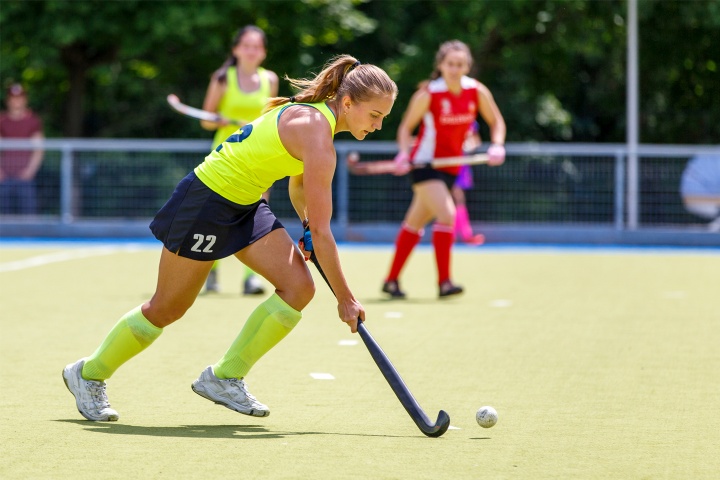
Quick Navigation
- Goal Dimensions
- Field Dimensions
- Field lines
- Why Are Hockey Pitches Wet?
- Why Are Hockey Pitches Blue?
- Download PDF
Hockey Goal Dimensions
The crossbar of a field hockey goal should be 2.14m above the ground, measured from the bottom of the crossbar. The inner edges of the upright goalposts must be 3.66m apart. This gives the goal entrance a total area of 7.83sqm. Field hockey goals must also be at least 1.2m deep at ground level and at least 0.9m deep at crossbar level.
Hockey goals are made of two upright posts, joined at the top by a horizontal crossbar, with a net positioned to catch the ball when it passes through the goalposts. The goalposts and crossbar must be white and rectangular in shape, and should be 2in (50mm) wide and 2-3in (75 mm) deep.
Professional hockey goals also include sideboards and a backboard, which stand 46cm (1ft 6in) from the ground. The backboard runs the full 3.66m width of the goal, while the sideboards are 1.2m deep.
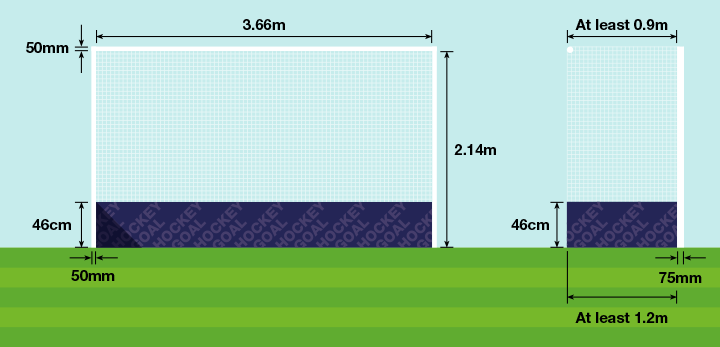
Dimensions of a Hockey Net
Hockey nets can come in different dimensions depending on how deep at ground level and at crossbar level the goal is. Typical dimensions for a standard field hockey net are around 3.7m (W) x 2.1m (H) x 1.2m (D).
How Wide is a Hockey Goal?
The International Hockey Federation states that field hockey goals must be 3.66m (12ft) wide, with the goalposts themselves not more than 50mm (2in) wide.
Field Hockey Goal Dimensions in Feet
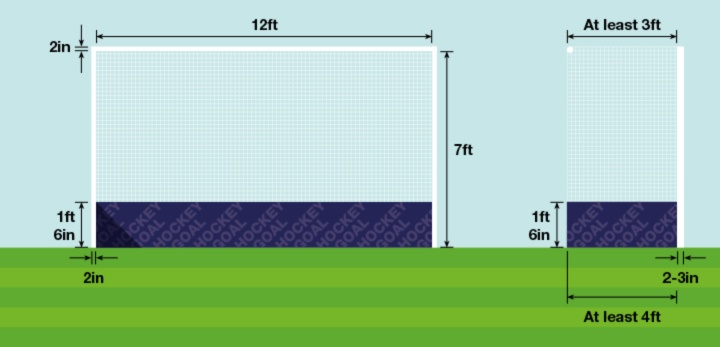
Field hockey goal dimensions in feet are as follows:
- Width between goalposts: 12 feet
- Distance from ground to bottom of crossbar: 7 feet
- Depth at ground level: minimum 4 feet
- Depth at crossbar level: minimum 3 feet
Hockey Field Dimensions
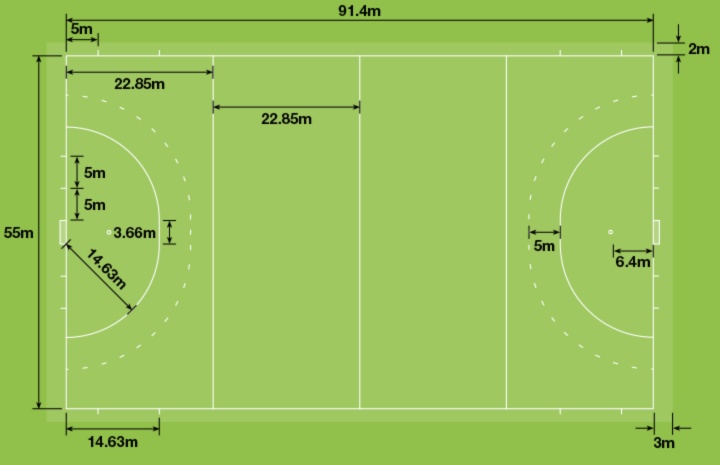
Hockey pitches are rectangular, with the longer edges (sidelines) measuring 91.4m long (100yd) and the shorter edges (backlines) measuring 55m wide (60yd). The total area of a standard field hockey pitch is 5,027sqm, which is 1.24 acres.
There must be at least 2m of run-off on either side of the field, and at least 3m of run-off at the backlines. The International Hockey Federation states that the last metre of run-off behind the backlines can be a different colour to the rest of the pitch if playing on artificial turf.
How big is a field hockey circle?
The striking circle, or penalty circle, in field hockey has a radius of 15m (16yd) and is actually a straight line with two quadrant arcs drawn at either side, to form a 'D' shape against the backline.
A straight line measuring 3.66m (4yd) – the same width as the goalposts – is positioned parallel to the goal, 14.63m (16yd) into the pitch. Two arcs, each with a radius of 14.63m, connect the ends of this line to the backline of the hockey field.
Hockey Field Dimensions in Feet
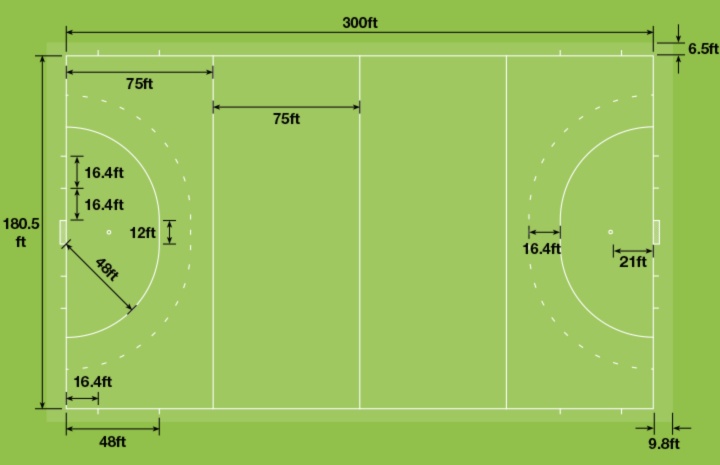
Hockey field dimensions in feet are as follows:
- Length of sidelines: 300 feet
- Width of backlines: 180.5 feet
- Run-off at sidelines: minimum 6.5 feet
- Run-off at backlines: minimum 9.8 feet
Field Hockey Lines
There are three main lines drawn across a field hockey pitch, spaced 22.85m (25yd) apart along the 91.4m (100yd) sidelines, reaching from side-to-side. The line in the centre of the field is called the half-way line, or centre line, and the two on either side are the 25 yard lines or 23 metre lines.
In addition to these three lines and the lines that make up the two striking circles, there are also a number of other markings on the field. From the centre of the backline, there are markers at 5m and 10m in either direction. These are the Penalty Corner Defender's and Attacker's marks. 10m is the mark from which an attacking team takes the penalty, and 5m is the mark for the closest position in which a defender may stand.
On each sideline there is also a mark 5m from the backline, which is the Long Corner Attacker's mark.
What is the dotted line in field hockey?
The dotted line in field hockey sits 5m outside the striking circle, and if a ball travels past the dotted line during a penalty corner, that penalty corner is now over. On pitches with no dotted line, the penalty corner is still over if the ball travels more than 5m outside of the striking circle.
The dotted line used to dictate the point where free hits must be taken from in the event of a foul within the 'D'. That rule was removed in 2015 and many pitches no longer feature the dotted line, as it is no longer an international requirement.
What is a 16 yard hit in field hockey?
In field hockey, a 16 yard hit is a free hit for the defending team after an opposition player commits a foul within the striking circle or hits the ball over the backline. It is taken 16yd (14.63m) from the backline.
Why Are Hockey Pitches Wet?
Hockey pitches are wet because water helps to reduce friction on the surface of the pitch, which allows the hockey ball to travel more smoothly. Water also helps to stop the ball bouncing, which can be dangerous for the hockey players, and reduces friction burns from artificial turf when players fall.
Why Are Hockey Pitches Blue?
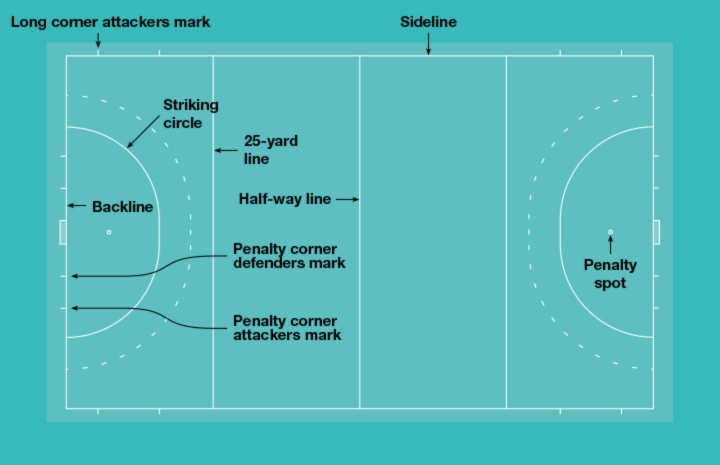
The London 2012 Olympics started a new trend for blue hockey pitches, because blue turf helps television viewers to clearly see the ball and markings on the hockey pitch during gameplay. Not all hockey pitches have to be blue, but a yellow ball on blue turf is now the standard for professional field hockey tournaments.
Download the PDF
Download our complete guide to hockey goal and field dimensions as a PDF here.
Did you know that we make hockey posts and equipment for many of the professional clubs? You can view our full hockey equipment range here.

